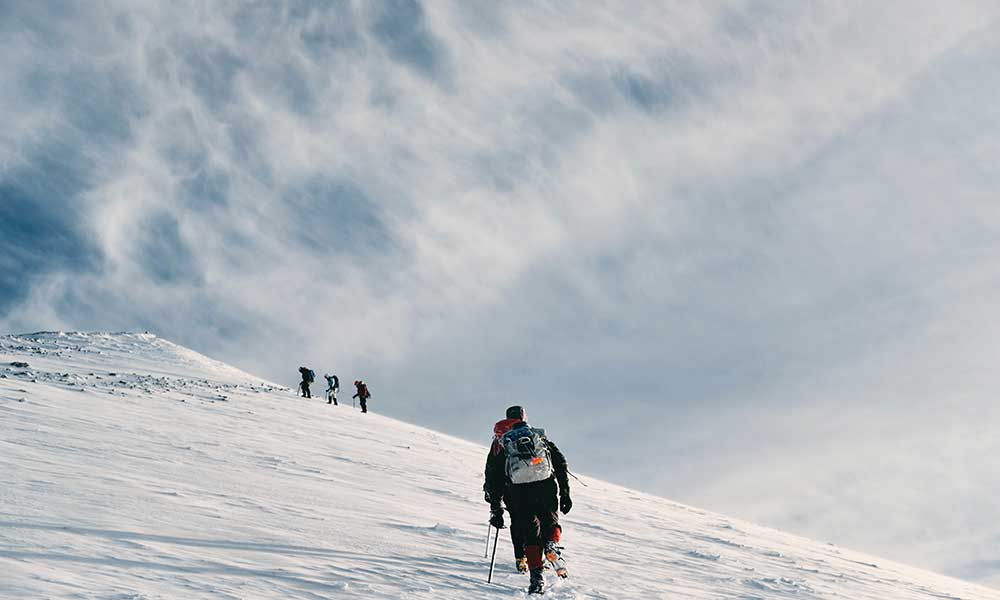While hiking in snowy conditions, sometimes we might get caught up in the moment and enjoy the scenery. All of sudden, you find yourself in knee-high snow. This is called postholing.
Postholing is a winter hiking word for digging an entire leg into fresh snow. It makes walking exhausting and agonizingly slow. It can also make the trail hazardous for anyone following in your footsteps. This is why hikers use snowshoes.
The best way to stop yourself from postholing is to keep your mobility and agility high by using low-impact techniques when hiking. By doing this, you will have the ability to react quickly and avoid any potential danger that might arise while on your hike
How To Avoid Post holing
Below are some of the procedures to take to avoid post-holing and snowshoeing:
1. Start your hike Early
Hiking in the early morning hours before the warming air temperatures and solar radiation allows hikers to avoid postholing, resulting in broken bones or even death. It also helps hikers save energy and make their trip shorter than usual to explore new locations and adventure.
2. Travel in places with mild snow conditions
It is best to hike in a place with mild snow conditions than in hard pack snow or where the snow is almost becoming dry ground.
However, there are periods of the year when it is better to focus on hiking in sunnier locations when there is soft snow, making it easier to walk.
The best hiking may be found in sunny exposures, particularly around the end of winter or at the beginning of spring.
3. Hike Through Shaded Areas
During late winter and early spring, the snow tends to be firmer and light when there is shade. Hiking through the shaded areas helps you to avoid deep and thick snow.
4. Move Around Snow Deposits
When late winter arrives, snow can make a hilly landscape appear flat and even. However, this is not the case, and the dips filled in by deep snow are where you are most likely to fall through the surface and hurt yourself. If you know what’s buried behind that snow, you can avoid regions with as much snow on the ground.
5. Get Snowshoes
Wearing snowshoes is another excellent alternative to avoid post holes—possibly the best—to help you get over soft patches when you come across them. You may easily fit snowshoes into any rucksack and attach them to your boots whenever the conditions require them.
Risks Associated With Post Holing
Postholing exposes you to genuine dangers due to the fact that you have no idea what is hiding beneath the surface of the snow until you punch through it and hit, scrape, or wedge your leg beneath, against, between, or in something like a hidden tree, log, rock, hole, creek, etc.
1. Barking Shins
After sinking two feet into the snow with some resistance for miles, you suddenly sink three feet rapidly while banging your shins against dead wood. This happens because the snow may be hollowed out a bit where the buried logs are located.
2. Wet Feet
Even while wearing gaiters, engaging in extensive post-holing can cause snow to find its way under the gaiters and into your shoes, leaving you with damp feet and increasing the risk of cold-related ailments (e.g., frostbite).
Soaked Feet
Even though it may look like there is no break in the snow, creeks may still be flowing. Postholing can immediately soak your feet and legs, raising your risk of cold injury and even leading to hypothermia if enough of you gets soaked.
Sprained Ankle, Torn Knee, Torn Muscle, or a Broken Leg
You don’t know what’s hiding just a few inches beneath the snow’s surface. Your unexpected stop could result in various soft tissue or skeleton injuries if you carry any amount of weight, if you are moving forward with momentum, or if you are just unlucky.
If You Find Yourself in a Post-holing Situation. What to do
You’re out enjoying your deep snow hike or even during winter, and you happen to hit post-holing. So what are you going to do? Follow the tips below
Find the best path or go back
Have you come across a little area of posthole snow that you can walk past, or has the entire snowpack become more pliable due to solar radiation and warm air? If the second option applies, would it be quicker to reach the shelter or the trailhead if you turned around and went back or if you continued moving forward? When making this selection, the weather conditions and your familiarity with the terrain are both significant elements to consider.
Look for more stable ground
Try walking in the tracks of other people or a place where few people have passed recently if you’re going hiking in an area where other people ski, snowshoe, or ride fat-tire bikes. There are instances when they pack the snow in the middle to the point that you won’t sink into it.
Grab your snowshoes
Bringing snowshoes with you is a helpful technique to circumvent the need for potholing altogether. It is true that carrying them is an additional hassle, but it is not nearly as much of a hassle as not going on the hike at all or having to posthole your way back.
Take the time to properly equip yourself with snowshoes and other winter gear before you head out on a winter trail that is covered in unpacked snow. This will allow you to be self-sufficient and prevent you from putting other people in danger in the event that you become lost and need to be rescued.
Snowshoers are asked to steer clear of ski trails. However, winter hikers aren’t the only ones who use trails, particularly in areas where cross-country skiing is also a popular activity.







